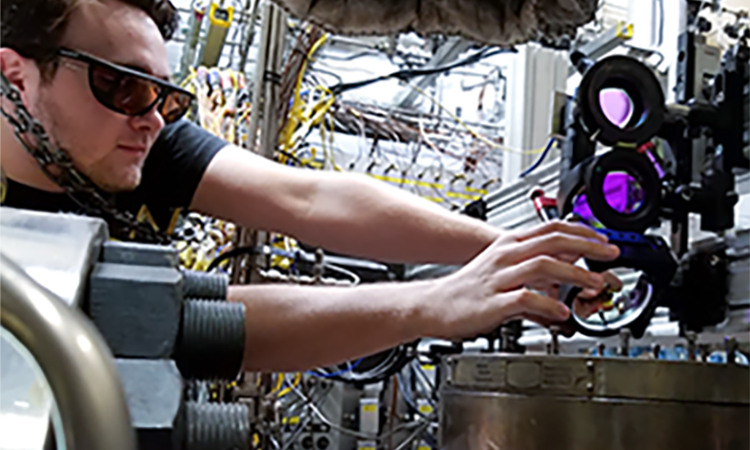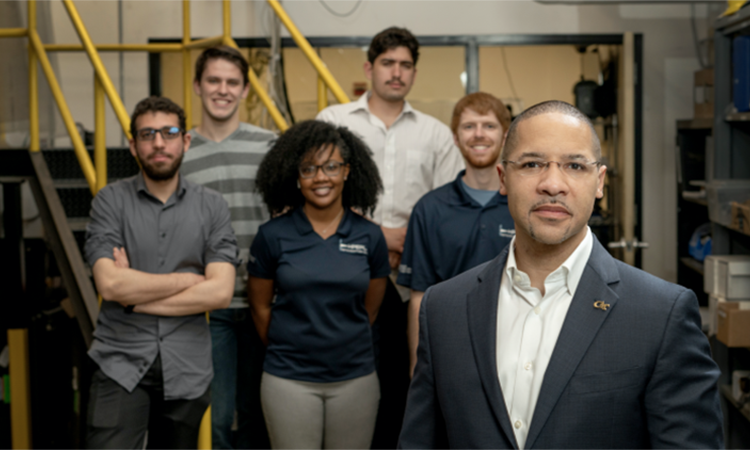Georgia Congressmen Rich McCormick and Mike Collins joined Pam Melroy for a tour of two AE labs.
Georgia Tech Aerospace Engineering (AE) faculty members and students recently welcomed NASA Deputy Administrator Pam Melroy to campus for a tour of AE labs. Melroy was joined by Georgia Congressmen Rich McCormick (6th district) and Mike Collins (10th district), who both serve on the House of Representatives’ Science, Space, and Technology Committee.
AE Professors Mitchell Walker and Adam Steinberg guided the trio and their guests through two signature AE facilities that conduct NASA-sponsored research.
Mitchell Walker (right) walks the invited guests to the High-Power Electric Propulsion Lab.
(text and background only visible when logged in)
The day’s first stop was the High-Power Electric Propulsion Laboratory (HPEPL), where six diffusion pumps served as the backdrop as Walker discussed their importance for the projects that include NASA’s Joint AdvaNced PropUlsion InStitute (JANUS). The facility supports research on electric propulsion, the use of electrical energy to propel spacecraft.
“In this lab, we answer questions such as, ‘How do you ensure that a thruster operates efficiently on a new propellant? How do you make sure the exhaust of the thruster interacts with the spacecraft the way you want it to? How do you make the thruster more fuel efficient,’” said Walker, JANUS director.
“We’re able to answer those questions with the help of a host of diagnostics composed of physical probes, lasers, and cameras capturing experimental data at a rate of thousands of samples per second. Our team of researchers and students run the diagnostics to see how the engines, power supplies, magnets, and cathodes are all performing,” he said.
AE undergraduates, Kevin Zhang and Sabrina Mayor met the guests while measuring specific parts for an experiment to test electrical facility effects.
The group then toured a second, larger vacuum test facility which features cryogenic pumping and tests engines capable of operating engines at 10’s of kilowatts of power, much higher than that on contemporary satellites.
(text and background only visible when logged in)
Mitchell Walker explaining the research that HPEPL conducts for industry leaders like NASA.
Rep. Mike Collins (left) talking to AE undergrads Sabrina Mayor and Kevin Zhang (right)
Following a short stroll across the street, the tour visited the 20,000-square-foot Ben T. Zinn Combustion Lab, where Steinberg talked about the state-of-the-art facilities and diagnostic tools used for investigating various combustion and fluid mechanical phenomena.
“We’re working to train the best experimental researchers in the world, while conducting cutting-edge research that will impact the future of sustainable propulsion, alternative fuels, and energy conversion,” shared Steinberg.
The Combustion Lab is the home to two NASA University Leadership Initiative (ULI) projects tasked with developing new technologies that produce cleaner and more sustainable aircraft, while strengthening partnerships with industry and other universities, including Atlanta’s Spelman College.
“We’re working to train the best experimental researchers in the world, while conducting cutting-edge research that will impact the future of sustainable propulsion, alternative fuels, and energy conversion.”
Adam Steinberg
Prof. Adam Steinberg shows how the Combustion Lab designs and uses custom-built equipment for research.
President Cabrera joined the group for more discussions about Georgia Tech's research.
During the tour, McCormick shared his insights as a former helicopter pilot about how human factors can affect vehicle fuel efficiency and navigation when operating high and low-speed aircraft.
“There are so many examples of outside of the box thinking that Georgia Tech does that are cutting-edge and will help lead us into new conversations and paths,” said McCormick.
They weaved in and out of several test cells where Steinberg and AE students showcased their impressive work and explained the real-world implications of their research.
“Seeing NASA funding in action with Rep. McCormick and Rep. Collins at Georgia Tech was incredibly impactful. The Institute’s electric propulsion lab is studying how we can improve our infrastructure and ground testing systems,” Melroy said.
“Likewise, advancements in sustainable aviation can be made thanks to projects in our University Leadership Initiative. We’re encouraged by the innovative culture Georgia Tech fosters to create technology that will create lasting economic impact while studying the universe.”
At the final stop, the group received a pleasant surprise when Georgia Tech President Ángel Cabrera greeted the guests and expressed his gratitude for their support.
President Cabrera joined the tour for some behind the scenes stops with Melroy and Reps. McCormick and Collins.
Rep. McCormick and Melroy inspect the high-temperature pressure vessel that houses the NASA ULI experiment, while Rep. Collins and Prof. Steinberg discuss its importance.
Exploring the future, one lab at a time: from left; Rep. Mike Collins, Steven Budzinski, Pam Melroy, Rep. Rich McCormick, President Ángel Cabrera, Winter Jones, Jeremiah Juergensmeyer, Prof. Ellen Mazumdar, Yassine Ben Zineb. Prof. Adam Steinberg, and Prof. Mitchell Walker.
(text and background only visible when logged in)
Related Stories:

Georgia Tech Has Been Selected on Four NASA University Leadership Initiative (ULI) Projects
The Daniel Guggenheim School is preparing to embark on four multidisciplinary team research projects as part of NASA’s University Leadership Initiative (ULI).

Georgia Tech Shares $15M From NASA to Advance Deep Space Exploration
The Georgia Institute of Technology, along with 11 partner universities and 17 researchers, will receive $15 million over five years to fund the Joint Advanced Propulsion Institute (JANUS).